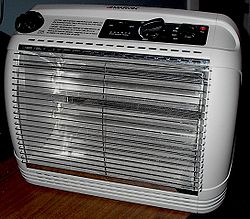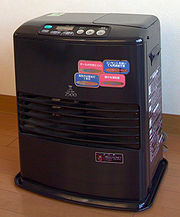
Space heating
Encyclopedia

Central heating
A central heating system provides warmth to the whole interior of a building from one point to multiple rooms. When combined with other systems in order to control the building climate, the whole system may be a HVAC system.Central heating differs from local heating in that the heat generation...
, which warms many connected spaces at once. Space heaters are usually portable or wall-mounted, and may use natural gas
Natural gas
Natural gas is a naturally occurring gas mixture consisting primarily of methane, typically with 0–20% higher hydrocarbons . It is found associated with other hydrocarbon fuel, in coal beds, as methane clathrates, and is an important fuel source and a major feedstock for fertilizers.Most natural...
or propane
Propane
Propane is a three-carbon alkane with the molecular formula , normally a gas, but compressible to a transportable liquid. A by-product of natural gas processing and petroleum refining, it is commonly used as a fuel for engines, oxy-gas torches, barbecues, portable stoves, and residential central...
, but are most commonly electric.
Types of heating
Space heaters can be divided into those that transfer their heat primarily by convection, or by radiation.Convective heaters
In convection heaters, heating elementHeating element
A heating element converts electricity into heat through the process of Joule heating. Electric current through the element encounters resistance, resulting in heating of the element....
s either warm the air directly or heat oil or another filler, which in turn transfers heat to the air. The air then warms the objects and people in the space. Convective heaters are suitable for providing constant, diffuse heat in well-insulated rooms. Oil heater
Oil heater
An oil heater, also known as an oil-filled heater, oil-filled radiator, or column heater, is a common form of convection heater used in domestic heating...
s warm up slowly but do not reach dangerous surface temperatures; wire-element heaters, which may be fan assisted, reach operating temperature much more quickly but may pose a fire hazard. One particular type of convective heater is the fan heater
Fan heater
thumb|Typical fan heater's internal partsthumb|Overheat cutoutsA fan heater is a heater that works by using a fan to pass air over a heating element. This heats up the air, which then leaves the heater, warming up the surrounding room...
.
Radiative heaters
HalogenHalogen
The halogens or halogen elements are a series of nonmetal elements from Group 17 IUPAC Style of the periodic table, comprising fluorine , chlorine , bromine , iodine , and astatine...
heaters usually comprise tungsten
Tungsten
Tungsten , also known as wolfram , is a chemical element with the chemical symbol W and atomic number 74.A hard, rare metal under standard conditions when uncombined, tungsten is found naturally on Earth only in chemical compounds. It was identified as a new element in 1781, and first isolated as...
filaments in heat-resistant quartz
Quartz
Quartz is the second-most-abundant mineral in the Earth's continental crust, after feldspar. It is made up of a continuous framework of SiO4 silicon–oxygen tetrahedra, with each oxygen being shared between two tetrahedra, giving an overall formula SiO2. There are many different varieties of quartz,...
envelopes, mounted in front of a metal reflector in a plastic case. They operate much like halogen light-bulbs, but radiate their energy primarily in the infrared spectrum. They convert up to 86% of their input power to radiant energy, losing the remainder to conductive and convective heat. The advantage of halogen heaters is that the radiation they produce is absorbed directly by clothing and skin, without first heating the air in the space. This makes them suitable for warming people in poorly-insulated rooms, or even outdoors.
Electric heaters
Modern electric space heaters may have ceramicCeramic
A ceramic is an inorganic, nonmetallic solid prepared by the action of heat and subsequent cooling. Ceramic materials may have a crystalline or partly crystalline structure, or may be amorphous...
or nichrome
Nichrome
Nichrome is a non-magnetic alloy of nickel, chromium, and often iron, usually used as a resistance wire. Patented in 1905, it is the oldest documented form of resistance heating alloy. A common alloy is 80% nickel and 20% chromium, by mass, but there are many others to accommodate various...
heating element
Heating element
A heating element converts electricity into heat through the process of Joule heating. Electric current through the element encounters resistance, resulting in heating of the element....
s, and may be fan-forced with a blower or a squirrel-cage fan to improve heat transfer. Window or wall-mounted units, often seen in hotel rooms, are permanent space heaters. These often employ efficient heat pump
Heat pump
A heat pump is a machine or device that effectively "moves" thermal energy from one location called the "source," which is at a lower temperature, to another location called the "sink" or "heat sink", which is at a higher temperature. An air conditioner is a particular type of heat pump, but the...
s, which use reverse-cycle air conditioning to transfer heat to the inside from the outside.
Gas heaters
Gas heaters use propane, butane, or liquefied petroleum gas. They may be convective or radiative, in the latter case by heating a matrix which then emits infra-red radiation. Gas heaters burn their fuel in air and produce carbon dioxide. In well-insulated rooms the oxygen concentration may drop and carbon monoxide may accumulate to toxic levels due to incomplete combustion. For this reason gas heaters should be used only in rooms with adequate ventilation. When used outdoors, for example as patio heaters, they present the dual advantage of portability and higher output (due to not being constrained by the current-carrying capacity of electrical wiring).Kerosene heaters

Kerosene heater
A kerosene heater, also known as a paraffin heater, is a portable, unvented, kerosene-fueled, space-heating device. In the United States they are used mainly for supplemental heat or as a source of emergency heat during a power outage. In some countries, particularly in Japan, they are used as...
s were once common, and are still widely used in some regions. Paraffin is used to heat many informal dwellings in South Africa, where it poses a risk of fire and carbon monoxide poisoning
Carbon monoxide poisoning
Carbon monoxide poisoning occurs after enough inhalation of carbon monoxide . Carbon monoxide is a toxic gas, but, being colorless, odorless, tasteless, and initially non-irritating, it is very difficult for people to detect...
.
Safety issues
The two primary health risks from heaters are the risk of fire, and the risk of carbon monoxide poisoning. The latter risk accompanies gas and kerosene heaters but not electric ones. The risk of fire from electric heaters may be mitigated by low surface temperatures (as found on oil-filled convective heaters), or by switches that cut power in the event of the device being knocked over (often found in the bases of halogen heaters), or by thermal cut-out switches.Within the United States, Underwriters Laboratories
Underwriters Laboratories
Underwriters Laboratories Inc. is an independent product safety certification organization. Established in 1894, the company has its headquarters in Northbrook, Illinois. UL develops standards and test procedures for products, materials, components, assemblies, tools and equipment, chiefly dealing...
maintains standards UL 1278
for portable electric space heaters, and UL 1042
for portable and fixed baseboard electric heaters. The General Services Administration
General Services Administration
The General Services Administration is an independent agency of the United States government, established in 1949 to help manage and support the basic functioning of federal agencies. The GSA supplies products and communications for U.S...
used to maintain Specification W-H-193
for electric space heaters, but this was cancelled in 1995 in favor of the UL standards. Additional information on portable heater safety may be found at the Department of Energy
United States Department of Energy
The United States Department of Energy is a Cabinet-level department of the United States government concerned with the United States' policies regarding energy and safety in handling nuclear material...
Energy Efficiency website. Also, the "EPA does not currently label space heaters as an ENERGY STAR
Energy Star
Energy Star is an international standard for energy efficient consumer products originated in the United States of America. It was first created as a United States government program during the early 1990s, but Australia, Canada, Japan, New Zealand, Taiwan and the European Union have also adopted...
qualified product...".
See also
- Central heatingCentral heatingA central heating system provides warmth to the whole interior of a building from one point to multiple rooms. When combined with other systems in order to control the building climate, the whole system may be a HVAC system.Central heating differs from local heating in that the heat generation...
- District heatingDistrict heatingDistrict heating is a system for distributing heat generated in a centralized location for residential and commercial heating requirements such as space heating and water heating...
- Electric heatingElectric heatingElectric heating is any process in which electrical energy is converted to heat. Common applications include space heating, cooking, water heating and industrial processes. An electric heater is an electrical appliance that converts electrical energy into heat...
- HeaterHeaterA heater is an object that emits heat or causes another body to achieve a higher temperature. In a household or domestic setting, heaters are usually appliances whose purpose is to generate heating...
(types of heaters) - Solar combisystemSolar combisystemA solar combisystem provides both solar space heating and cooling as well as hot water from a common array of solar thermal collectors, usually backed up an auxiliary non-solar heat source....
- Carbon MonoxideCarbon monoxideCarbon monoxide , also called carbonous oxide, is a colorless, odorless, and tasteless gas that is slightly lighter than air. It is highly toxic to humans and animals in higher quantities, although it is also produced in normal animal metabolism in low quantities, and is thought to have some normal...

